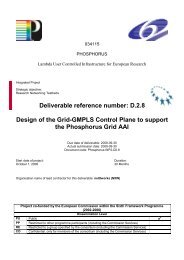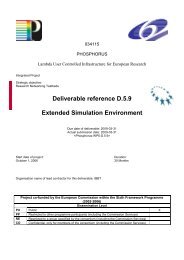Grid Job Routing Algorithms - Phosphorus
Grid Job Routing Algorithms - Phosphorus
Grid Job Routing Algorithms - Phosphorus
Create successful ePaper yourself
Turn your PDF publications into a flip-book with our unique Google optimized e-Paper software.
<strong>Grid</strong> <strong>Job</strong> <strong>Routing</strong> <strong>Algorithms</strong>attributes. This information should be frequently updated in order to provide a high degree of accuracy andcorrectness to the IA-RWA algorithms implemented in the distributed control plane. For this purpose, theexistent GMPLS-based routing protocols need to be extended to flood optical performance parameters astraffic engineering (TE) attributes are disseminated [Strand01]. Impairment-related parameters are carried onthe TE Link State Advertisements (TE-LSA) [Kompella05]. In particular, information is encapsulated within thetop-level Link Type/Length/Value (TLV) as a common sub-TLV, which is referred as impairment sub-TLV. Thecontents of the impairment sub-TLV are: Type, which is used to identify uniquely this sub- TLV, Length, whichcontains the total length (in bytes) including the header of the sub-TLV, and Value, which contains the linkparameters considered (e.g., OSNR, PMD). The construction of the proposed Impairment sub-TLV is similar asstandardized TE information (link metric, unreserved bandwidth, etc.) Therefore, an on-line monitoring systemcan inform the Link Resource Manager (LRM) about changes in physical parameters such as ASE noise orPMD penalties in adjacent links which in turn informs the <strong>Routing</strong> Controller (RC) in order to flood the newphysical value to the entire network by using the appropriate extensions to OSPF-TE [Martinez06]. As a resultof the flooding mechanism every node’s TED will be aware of the new impairment parameter value even if thelink is not adjacent. This global information will be used by the IA-RWA algorithm during the path computation.The possible path computation procedures identified in the context of PHOSPHORUS as define in [G 2 MPLS-ARCH] should be in compliance with the IETF Path Computation Element (PCE) architectural model [Farrel06]since most of the protocol-specific issues are defined and solved in this framework. The integration of physicallayer parameters in the control plane following this approach can be accomplished by introducing a separatecomponent responsible for the inter- and intra-domain path computation based on specified constrains. Thiscomponent can be identified as an application (different building block) residing within or externally to a networknode, providing optimal routes and interacting with the control plane for the establishment of the proposedpaths. The Path Computation Element (PCE) is an entity (component, application or network node) that iscapable of computing a network path or route based on a network graph and applying computationalconstraints during the computations [Farrel06]. The deployment of a dedicated PCE will relax the processingpower needed by a network node to run constrained based routing algorithms and implement highly CPUintensiveoptimization techniques. Also it may eliminate the need for the network nodes to maintain the memorydemanding Traffic Engineering Database (TED) by establishing it on a separate node and making it availablefor path computation through the PCE. Another incentive that makes the solution of a separate PCE attractiveis the optimal inter-domain routing which can be handled through distributed computation with cooperationamong PCEs within each of the domains or even by a central PCE that has access to the complete set oftopology information. Additionally the PCE can in an efficient manner consider local policies that impact thepath computation and selection, in response to a path computation request, and also it can be used to computebackup paths in the context of fast reroute protection. Finally the sophisticated constraint routing algorithmsutilize by the PCE can in a convenient way address issues like: i) resource coordination (e.g. CPUs, storage) ii)advance reservation iii) physical layer impairments in transparent optical networks iii) different connection types(unicast, multicast or anycast) and iv) QoS, separately or simultaneously in an integrated manner.The PCE could represent a local Autonomous Domain (AD) that acts as a protocol listener to the intra-domainrouting protocols e.g. OSPF-TE, and is also responsible for inter-domain routing. PCEs peer across domainsand exchange abstract or actual topology information to enable inter-domain path computation and also utilizea modified version of OSPF-TE to share a link state database between domains. The constraint pathcomputation process performed by the PCE can be described briefly in the following steps. Upon a requestProject:PHOSPHORUSDeliverable Number: D.5.3Date of Issue: 31/06/07EC Contract No.: 034115Document Code: <strong>Phosphorus</strong>-WP5-D5.327






